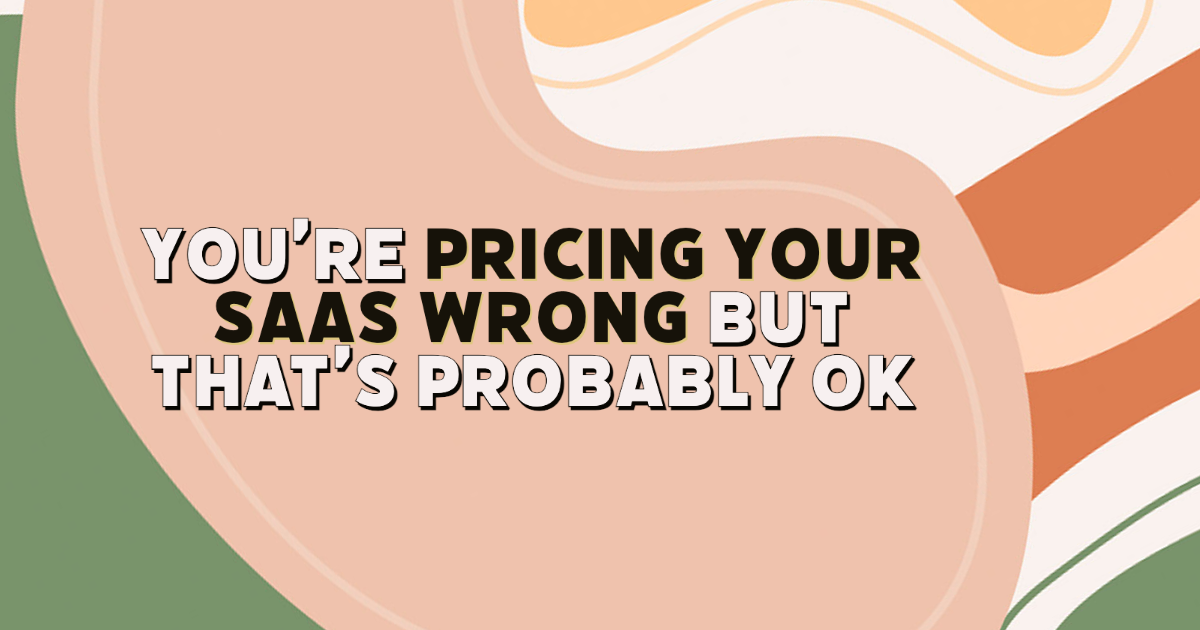Previously, I wrote about how important it is to Design your pricing and tools so you can adapt them later – now I want to give a little bit more material on that…
I’m going to assume that you’re some sort of SaaS founder, or perhaps even a product manager for pricing, growth, or monetisation.
You might be in the phase of wanting to charge for your product. Good! You should.
However, you for sure don’t know the full value you present to your customers. You probably spend a lot of time thinking about how to price it.
You’ve done extensive market research, competitor analysis, customer interviews, and you’ve come up with a value-based pricing model to come up with the perfect number.
But guess what? You’re probably wrong.
Yep, wrong. Like, not you yourself. But your pricing.
I think that’s OK though.
More than set-and-forget
Pricing is not a one-time decision that you “set and forget”. It’s an ongoing process of experimentation and iteration that you need to embrace and enjoy.
Why? Because SaaS pricing is hard.
It’s not a science. It’s more like an art, but not only that – it’s extremely succeptible to being a fashion trend too.
There are so many factors that influence how much customers are willing to pay for your product or service, and they change all the time.
As you get more customers, or even more users within an individual “customer” – their needs, preferences, expectations, and their patience can change how your product offering is perceived.
Plus, there’s the market. Alternatives, competitors, market conditions, and more can affect how they feel about your value proposition.
How do you deal with this uncertainty?
Set up some governance
It’s an awful word, but that’s what you need.
You need to set up a light process for trying and modifying your pricing.
You need to test and learn…
Instead of obsessing over getting it right once, set up a process.
Process is a scary word, but it can be a recurring meeting with key stakeholders like the CRO or VP Sales, as well as marketing.
Setting up the governance and processes will make sure you build a muscle that you can train, and it’ll get easier over time. It also means that you can reject deals/contracts that don’t make sense for your pricing.
It guides everyone.

Image Source: How to Use Waterfall Pricing to Increase Profits – Vendavo
This way, you can align on the goals and metrics of your pricing strategy, and establish a feedback loop to adjust what needs adjusting
Some of those feedback loops could be surveys, interviews, A/B tests, and analytics on things like MRR, LTV, CAC, to name a few.
Actually, let’s talk about that experimentation and validation.
There’s one thing you shouldn’t do, and consultants HATE IT
You shouldn’t get/need a consultancy to help you price.
Unless you’re a company with a very very complex structure and offering, you don’t need consultants.
Consultants will often charge you €500,000 – €1,500,000 for something you can come up with yourself. And more importantly, they won’t be there to help you when it is eventually wrong without a big additional investment.
So, yeah, you can and should do this yourself. Because whether you like it or not, we’re all “pricing experts”. We make hundreds of decisions a month around pricing when we go to a supermarket, buy stuff online, pause a subscription to something.
You can do this yourself with the right mindset. And that mindset, is experimentation.
Experimentation is key
Some people call it experimentation when they set a random price and go for it.
That can work, honestly.
I swear, it can work! It may be hard to defend, though. So, ideally, you should do some homework.
This homework will help you develop a solid rationale for your initial pricing. You should also recognise that it’s not set in stone and that you can always improve it over time.
Be flexible. Set a hypothesis and pressure test it. Accept that you may need to change it, no matter how good you think it is.
Test how it works:
- How does the pricing affect your ARPU? (you can simulate this)
- How does the pricing affect the LTV? (this will be hard to test ‘virtually’ but try anyway)
- How does the pricing affect customer retention? (this one is also hard)
- How does the pricing stack up to competition? (you can do the market research)
- How expensive does your pricing feel? (this one you can ask your customers about)
What should you be playing with?
Don’t be afraid to experiment with different pricing options.
SaaS Pricing is more than just €9.99 vs €12.
SaaS Pricing often means tiering, bundling add-ons and extra features, discount strategy, trials, reverse trials for some reason, freemium, how you upsell, cross-sell, etc.

Image source: SaaS Pricing Models Guide: Types, Examples and Top Metrics to Track (chargebee.com)
See what works and what doesn’t. Learn from your successes and failures. And most importantly, have fun with it.
It can be fun
Pricing is stressful the first time around. Knowing you don’t have to get it right the first time will make it less stressful.
Think of it as a creative challenge – because it is. I said it’s an art, and a fashion. Be curious about it!
It’s a great opportunity to learn more about your customers and your product and to deliver more value to both.
So go ahead and play with your pricing. You might be surprised by what you discover.
And don’t get a consultancy.

Leave a Reply